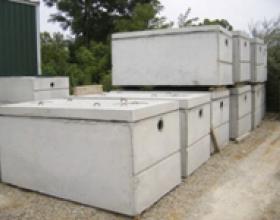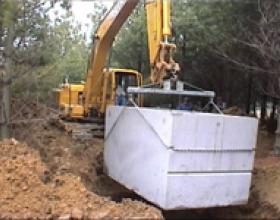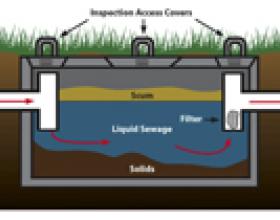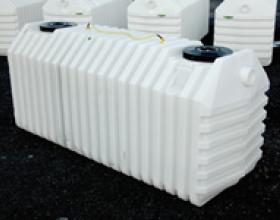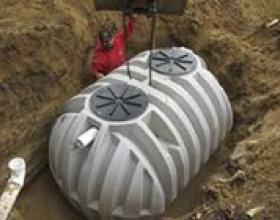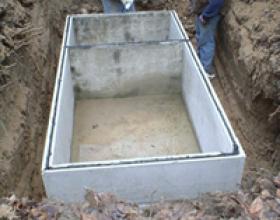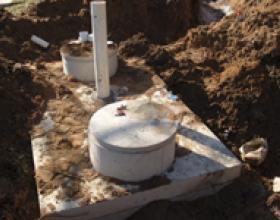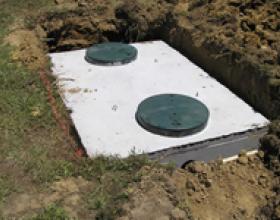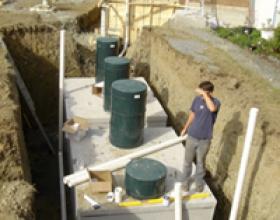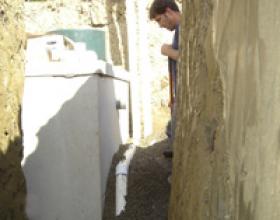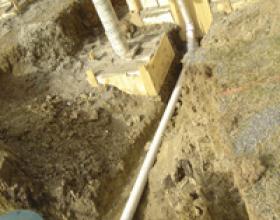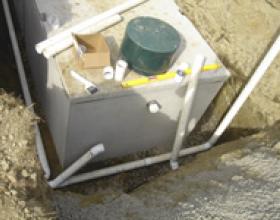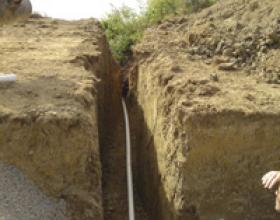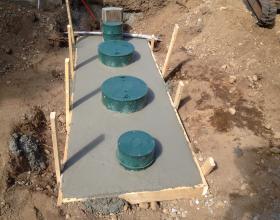Pacific Group Developments wants to help educate our clients about the process, parts, materials, installation and assembly of septic tanks. This page is designed to help you understand what you need to know about septic tanks.
About Septic Tanks
There are many types, shapes and sizes of septic tanks. Some have a single use while others have a multiple uses.
A septic tank is simply a big concrete, plastic or fibreglass tank that’s buried in a homeowner’s yard. The tank might hold anywhere from 1,800 litres to 4,500 litres of sewage. Wastewater enters the tank at one end and leaves the tank at the other. Anything that floats to the top of the water inside the tank is called the scum layer. Anything heavier sinks to the bottom to form the sludge layer. In the middle is a fairly clear water layer. This water contains bacteria and chemicals like nitrogen and phosphorous that act as fertilizers, but it’s largely free of solids.
A second chamber is standard on most larger tanks installed after 1975. It’s important to maintain the septic system properly to keep the second tank and the drain field free and clear of solids.
A septic system naturally produces gases, the product of bacteria breaking down the organic material in the wastewater. These gases don’t usually smell very good. In order to stop the gases from seeping back up the pipe and into a person’s home, sinks and tubs are installed with p-traps. The loops of the traps hold water, which block the gases from flowing back into the house. Instead, the gases flow up a vent pipe. Look at the roof of almost any house and you’ll see a number of vent pipes poking through.
As new water enters the tank, it displaces the water that’s already there. This water flows out of the septic tank and into the drain field. A drain field is made of perforated pipes buried in trenches filled with gravel.
In days gone by, stone septic tanks and wood septic tanks were used. Occasionally we still come across old wooden tanks. They’re always heavily decayed and need replacing. Provincial codes have changed to prohibit the use of wood or stone tanks.
Types of Septic Tanks
Now, principally concrete, plastic and fibreglass septic tanks are used. In some cases in different areas steel tanks are being used, but the Southern Vancouver Island region is too wet. Steel tanks are prone to rusting out, therefore they’re not used here.
Concrete septic tanks - Concrete septic tanks come in many shapes and sizes. They’re commonly used and have several benefits that fibreglass and plastic tanks do not have. Concrete is very strong and does not crack or break easily. The lids are able to withstand a lot more weight. The concrete septic tanks are available with several options such as single chamber, double chamber, triple chamber, forced-sedimentation chambers, baffles, filter ports and heavy-duty lids.
Plastic septic tanks - Plastic septic tanks are a popular option for several reasons. Plastic septic tanks are light and easily moved, saving time and reducing crane-truck costs. As well, they’re durable and quite resilient. Plastic tanks have ribs for strengthening the tank and helping to prevent collapse.
Plastic tanks are also available with the same options as the concrete tanks. Plastic tanks, however, are not strong enough to drive over or beside without risk of collapse. Some manufacturers will include various types of additional sewage treatment methods in plastic tanks due to the benefit of being lightweight. These packages are referred to as a “septic package plant” or “sewage treatment plant.”
Fibreglass septic tanks - Fibreglass septic tanks are also used and offer the same weight benefits as the plastic septic tank. Fibreglass septic tanks are brittle in comparison to plastic tanks and have similar characteristics regarding collapse with too much weight beside or above. Therefore vehicles and equipment must be kept away from the tanks. Like the plastic tanks, many sizes and shapes are available. Internal setups such as baffles, chambers, sedimentation chambers and filter assemblies are also available with fibreglass septic tanks.
The plastic and fibreglass can only be used once it has been determined that the ground is well drained as these tanks are light and will float, creating many problems. If the soil does not drain well, a drainage system may be installed around the tank to remove groundwater and hydrostatic pressure.
Concrete, plastic and fibreglass tanks may all be fitted with “risers,” which are columns with access lids put over the tank allowing you to cover the tank with more dirt and still be able to get to the access lids, making it easier for maintenance or pumping.
Some septic systems may require the use of a “sewage effluent pump.” This pump may be used to lift sewage to your septic tank or used to lift sewage effluent to your drain field. This pump is either located in a separate “pump chamber,” which is a small tank, or in a separate chamber within the septic tank.
Our technical staff is here to help you decide which type of tank best suits your needs and budget.

